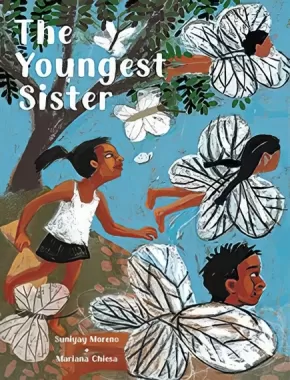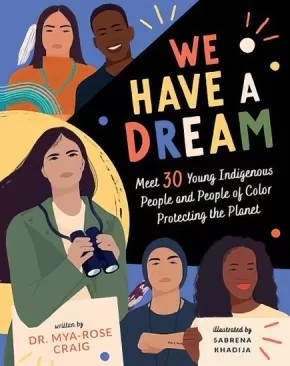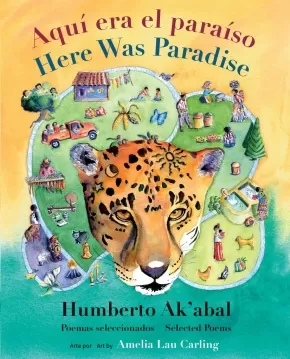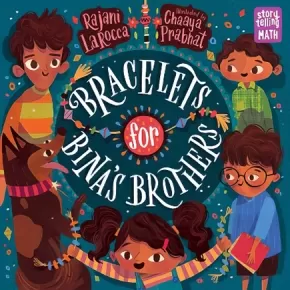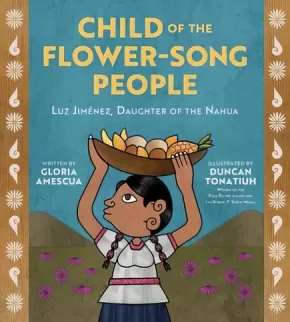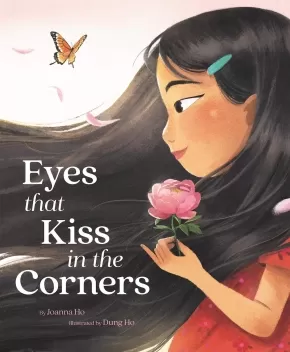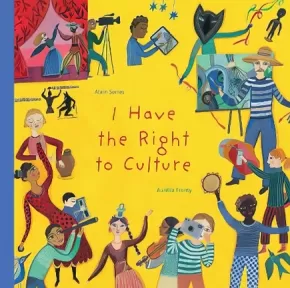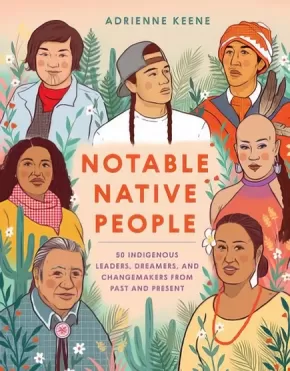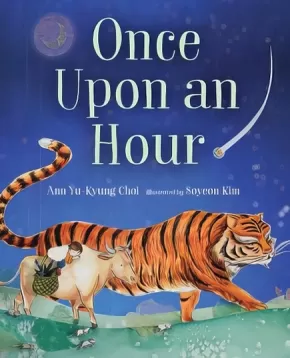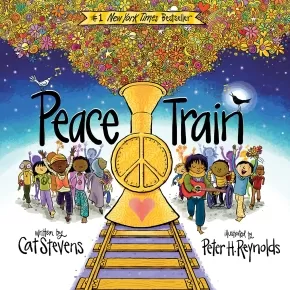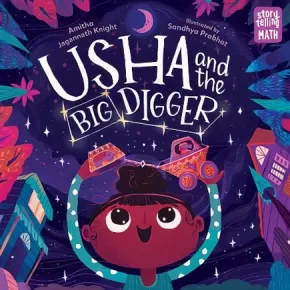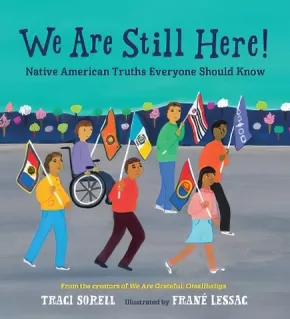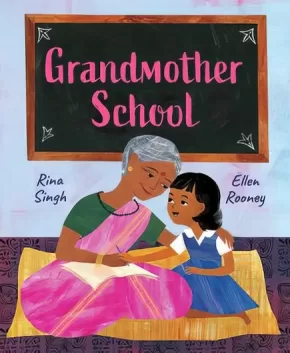
Multicultural Books
31
-
45
of
82 Results;
Sort By
Go To
of 6
The Youngest Sister
$22.95
Artists:
Format:
Hardcover
Text Content Territories:
Indigenous South American;
ISBN / Barcode: 9781771648752
Synopsis:
Synopsis:
“The small shall be large . . . that's how it must be.”
In the Andean foothills, a five-year-old Quechua girl is entrusted with a big job: to collect a marrow bone from the neighbor for the family soup. A stunning debut from Indigenous author Suniyay Moreno.
Picu’s family is very poor. In the dry Andean foothills, her mother must feed fourteen people—her kids, her relatives’ kids, and the hired hand’s kids—every day. One morning, Picu, the youngest sister, is sent to get a marrow bone from a neighbor. The bone will add flavor and nutrition to the lunchtime soup. Her mother warns her not to dawdle on the two-hour walk, each way, through the wild landscape.
But Picu can’t help it! She marvels at the butterflies, samples the cactus fruit, and daydreams about using the marrow bone as a football. Will the neighbor let her family keep the bone after the soup is made? Will her mother let her play with it? And will she be punished for being so late?
Picu is a child of joie de vivre and resourcefulness. This story, like Picu herself, is tough, hard, and honest. And moving. And fun.
The Youngest Sister features a glossary of Quechuan terms that are used throughout the story.
Reviews
“The vibrant illustrations are eye-catching and have the look of vigorously applied pastels. Could possibly find use within social studies units on South America.”—School Library Connections
"A memorable story alive with the voice of an Indigenous people seldom heard from." - Kirkus Reviews
Educator Information
Recommended for ages 5 to 8.
Curriculum Connections: Global Indigenous Peoples / Poverty / Cultural Diversity / Exploration & Imagination / Resourcefulness
Additional Information
40 pages | 7.00" x 9.50" | Hardcover
We Have a Dream: Meet 30 Young Indigenous People and People of Color Protecting the Planet
$22.99
Artists:
Format:
Hardcover
Text Content Territories:
Indigenous;
ISBN / Barcode: 9781419756665
Synopsis:
Synopsis:
Thirty young environmental activists share their dreams with voice of a generation Mya-Rose Craig.
Indigenous people and people of color are disproportionately affected by climate change. And yet they are underrepresented within the environmental movement. But not anymore.
Written by the extraordinary environmental and campaigner for equal rights Mya-Rose Craig—aka Birdgirl—this book profiles 30 young environmental activists who are Indigenous people or people of color, from communities on the frontline of global climate change. Each speaks to the diverse set of issues they are fighting for, from water conservation, to deforestation, to indigenous rights, and shares their dream . . .
A dream for climate justice.
A dream for a healthy planet.
A dream for a fairer world, for all.
From wildlife conservation to clean water, air pollution to plastic waste, climate justice to climate strikes, the time has come to listen to a generation of young people of colour demanding urgent change for the world they will inherit.
This is the first book from Craig, who shared a stage with Greta Thunberg in 2019’s climate strikes. Some of the activists profiled include Marshallese ocean activist Litokne Kabua; @ThisIsZeroHour founder Zanagee Artis; indigenous rights activists Thomas Tonatiuh Lopez Jr., and Caitlyn Baikie; climate justice activist Rebeca Sabnam, and clean water activist Autumn Peltier.
Educator Information
Recommended for ages 8 to 12.
Additional Information
64 pages | 7.00" x 9.00" | Hardcover
Aquí era el paraíso / Here Was Paradise (1 in stock, in reprint)
$19.99
Artists:
Format:
Hardcover
Text Content Territories:
Indigenous Central American; Maya;
ISBN / Barcode: 9781773064956
Synopsis:
Synopsis:
A collection of poetry by one of the greatest Indigenous poets of the Americas about the vanished world of his childhood — that of the Maya K’iche’.
Aquí era el paraíso / Here Was Paradise is a selection of poems written by the great Maya poet Humberto Ak’abal. They evoke his childhood in and around the Maya K’iche’ village of Momostenango, Guatemala, and also describe his own role as a poet of the place.
Ak’abal writes about children, and grandfathers, and mothers, and animals, and ghosts, and thwarted love, and fields, and rains, and poetry, and poverty, and death.
The poetry was written for adults but can also be read and loved by young people, especially in this collection, beautifully illustrated by award-winning Guatemalan-American illustrator Amelia Lau Carling.
Ak’abal is famous worldwide as one of the great contemporary poets in the Spanish language, and one of the greatest Indigenous poets of the Americas. Ak’abal created his poems first in K’iche’, then translated them into Spanish.
Educator Information
Recommended for ages 9+.
Dual-language in English and Spanish.
Key Text Features: foreword, biographical information, poems, translation
Correlates to the Common Core State Standards in English Language Arts:
CCSS.ELA-LITERACY.RL.4.2
Determine a theme of a story, drama, or poem from details in the text; summarize the text.
CCSS.ELA-LITERACY.RL.5.4
Determine the meaning of words and phrases as they are used in a text, including figurative language such as metaphors and similes.
CCSS.ELA-LITERACY.RL.5.5
Explain how a series of chapters, scenes, or stanzas fits together to provide the overall structure of a particular story, drama, or poem.
CCSS.ELA-LITERACY.RL.5.7
Analyze how visual and multimedia elements contribute to the meaning, tone, or beauty of a text (e.g., graphic novel, multimedia presentation of fiction, folktale, myth, poem).
CCSS.ELA-LITERACY.RL.6.2
Determine a theme or central idea of a text and how it is conveyed through particular details; provide a summary of the text distinct from personal opinions or judgments.
CCSS.ELA-LITERACY.RL.6.5
Analyze how a particular sentence, chapter, scene, or stanza fits into the overall structure of a text and contributes to the development of the theme, setting, or plot.
Excerpt from the Introduction by Patricia Aldana: "In this book we find poems about children, and grandfathers, and mothers, and animals, and ghosts, and thwarted love, and fields, and rains, and poetry, and poverty, and death. Ak'abal never pretended that life in his world was easy. The history of Guatemala is complex. It has the highest Indigenous population as a percentage of any country in the Americas. And Maya people have suffered terrible discrimination, violence and poverty since the arrival of the Europeans. But Ak'abal's poems convey how all his world's elements also came together to create a deep, rich reality.... Reading these wonderful poems can remind us that it is still possible to fight to protect this beautiful world and the people who live in and on it."
Additional Information
172 pages | 6.50" x 8.31" | 14 Colour Illustrations | Hardcover | Translated by Hugh Hazelton
Bracelets for Bina's Brothers
$9.99
Artists:
Format:
Paperback
ISBN / Barcode: 9781623541989
Synopsis:
Synopsis:
Celebrate diversity, math, and the power of storytelling!
For the Hindu holiday of Raksha Bandhan, Bina is determined to make beaded bracelets for her brothers all by herself. She finds out which colors her brothers like and dislike and sets to work. Working with her every-other-one beading pattern causes Bina to discover something new about patterns--and her brothers.
Reviews
"For the Hindu holiday of Raksha Bandhan, which celebrates the bond between siblings, Bina, who has warm brown skin and dark wavy pigtails, sets out to make her three older brothers—book-loving Vijay, musical Siddharth, and athletic Arjun—bracelets to keep them safe. There’s just one thing she must keep in mind: each brother has one color he favors and one that he doesn’t. After Mommy helps Bina buy green, blue, and orange beads, the girl sets out to make individualized bracelets, relying on the family dog for emotional support. LaRocca’s prose is accessible, with plenty of dialogue, and Prabhat’s digital art charms via vivid, dynamic spreads. This latest installment of Charlesbridge’s Storytelling Math series proves both educational and appealing. Back matter includes an author’s note and an explanation of the patterns involved in Bina’s bracelet making." —Publishers Weekly
Educator & Series Information
Recommended for ages 3 to 6.
The Storytelling Math series celebrates children using math in their daily adventures as they play, build, and discover the world around them. Joyful stories and hands-on activities make it easy for kids and their grown-ups to explore everyday math together. Developed in collaboration with math experts at STEM education nonprofit TERC, under a grant from the Heising-Simons Foundation.
Additional Information
32 pages | 9.50" x 9.50" | Paperback
Child of the Flower-Song People
$23.99
Format:
Hardcover
Text Content Territories:
Indigenous Central American; Indigenous Peoples in Mexico; Nahuas; Aztec; Nahuas;
ISBN / Barcode: 9781419740206
Synopsis:
Synopsis:
Award-winning illustrator Duncan Tonatiuh brings to life debut author Gloria Amescua's lyrical biography of an indigenous Nahua woman from Mexico who taught and preserved her people's culture through modeling for famous artists
She was Luz Jiménez,
child of the flower-song people,
the powerful Aztec,
who called themselves Nahua—
who lost their land but who did not disappear.
As a young Nahua girl in Mexico during the early 1900s, Luz learned how to grind corn in a metate, to twist yarn with her toes, and to weave on a loom. By the fire at night, she listened to stories of her community’s joys, suffering, and survival, and wove them into her heart.
But when the Mexican Revolution came to her village, Luz and her family were forced to flee and start a new life. In Mexico City, Luz became a model for painters, sculptors, and photographers such as Diego Rivera, Jean Charlot, and Tina Modotti. These artists were interested in showing the true face of Mexico and not a European version. Through her work, Luz found a way to preserve her people's culture by sharing her native language, stories, and traditions. Soon, scholars came to learn from her.
This moving, beautifully illustrated biography tells the remarkable story of how model and teacher Luz Jiménez became “the soul of Mexico”—a living link between the indigenous Nahua and the rest of the world. Through her deep pride in her roots and her unshakeable spirit, the world came to recognize the beauty and strength of her people.
The book includes an author’s note, timeline, glossary, and bibliography.
Reviews
“Gloria Amescua narrates the amazing life of Luz Jiménez with lyrical beauty that echoes the very xochicuicatl—ancestral Nahua poetics—that Luz sought to preserve for her people. Child of the Flower-Song People deftly balances fascinating biographical moments with an earnest sense of social justice for the indigenous people of Mexico. Duncan Tonatiuh’s now famous codex-style art, drawn from his own Nahua heritage, makes the story and message even more poignant.” - David Bowles
"An important window into the ravages of colonialism and the plight of the Indigenous peoples of Mexico." - Kirkus Reviews
Educator Information
Recommended for ages 6 to 10
Additional Information
48 pages | 9.00" x 10.00" | Hardcover
Eyes that Kiss in the Corners
$21.99
Artists:
● Dung Ho
Format:
Hardcover
ISBN / Barcode: 9780062915627
Synopsis:
Synopsis:
This lyrical, stunning picture book tells a story about learning to love and celebrate your Asian-shaped eyes and is a celebration of diversity.
A young Asian girl notices that her eyes look different from her peers'. They have big, round eyes and long lashes. She realizes that her eyes are like her mother’s, her grandmother's, and her little sister's. They have eyes that kiss in the corners and glow like warm tea, crinkle into crescent moons, and are filled with stories of the past and hope for the future.
Drawing from the strength of these powerful women in her life, she recognizes her own beauty and discovers a path to self-love and empowerment. This powerful, poetic picture book will resonate with readers of all ages.
Reviews
“When the narrator comes to describe her own eyes and acknowledges the power they hold, she is posed against swirling patterns, figures, and swaths of breathtaking landscapes from Chinese culture. This tale of self-acceptance and respect for one’s roots is breathtaking.” — Kirkus Reviews (starred review)
“A young girl finds beauty in her uniqueness.” —School Library Journal (starred review)
“A poignant testament to familial love and legacy.”— Publishers Weekly
Educator Information
Recommended for ages 4 to 8.
Subjects / Themes / Keywords: Self-Esteem; Self-Acceptance; #ownvoices story; Family; Diverse Picture Books
Additional Information
40 pages | 9.00" x 11.00"
I Have the Right to Culture
$19.99
Artists:
Format:
Hardcover
ISBN / Barcode: 9781773064901
Synopsis:
Synopsis:
From the author and illustrator duo who created the award-winning I Have the Right to Be a Child and I Have the Right to Save My Planet comes this beautifully illustrated third book in the series.
I Have the Right to Culture explores a child’s right to be curious and to experience all of humanity’s shared knowledge, including music, art, dance and much more. When a child is born, they learn the language of their parents, they sing the songs of their grandparents and they eat the delicious food that their family prepares. They also start to wonder about the lives of other children who live far away. What languages do they speak? What songs do they sing? And what games do they play?
Every child has the right to learn about the world they live in, including its history and its inventions. Every child has the right to learn about artists, about writers, about potters and photographers and architects, about musicians and dancers and poets. All of humanity’s treasures are for sharing, and every child has the right to know about what has come before them! Children have the right to partake in culture as proclaimed in the United Nations Convention on the Rights of the Child.
Told from the perspective of a child, this colorful and vibrant book explores what it means to be a child who has the right to find beauty in their world.
Educator & Series Information
Recommended for ages 3 to 6.
This book is part of the I Have the Right series.
Correlates to the Common Core State Standards in English Language Arts:
CCSS.ELA-LITERACY.RI.K.1
With prompting and support, ask and answer questions about key details in a text.
CCSS.ELA-LITERACY.RI.K.6
Name the author and illustrator of a text and define the role of each in presenting the ideas or information in a text.
CCSS.ELA-LITERACY.RI.K.7
With prompting and support, describe the relationship between illustrations and the text in which they appear (e.g., what person, place, thing, or idea in the text an illustration depicts).
CCSS.ELA-LITERACY.RI.1.8
Identify the reasons an author gives to support points in a text.
Additional Information
48 pages | 10.00" x 10.00" | Hardcover
Notable Native People: 50 Indigenous Leaders, Dreamers, and Changemakers from Past and Present
$24.99
Artists:
Format:
Hardcover
Text Content Territories:
Indigenous American; Alaska Native; Native American; Indigenous Hawaiian;
ISBN / Barcode: 9781984857941
Synopsis:
Synopsis:
An accessible and educational illustrated book profiling 50 notable American Indian, Alaska Native, and Native Hawaiian people, from NBA star Kyrie Irving of the Standing Rock Lakota to Wilma Mankiller, the first female principal chief of the Cherokee Nation
Celebrate the lives, stories, and contributions of Indigenous artists, activists, scientists, athletes, and other changemakers in this beautifully illustrated collection. From luminaries of the past, like nineteenth-century sculptor Edmonia Lewis—the first Black and Native American female artist to achieve international fame—to contemporary figures like linguist jessie little doe baird, who revived the Wampanoag language, Notable Native People highlights the vital impact Indigenous dreamers and leaders have made on the world.
This powerful and informative collection also offers accessible primers on important Indigenous issues, from the legacy of colonialism and cultural appropriation to food sovereignty, land and water rights, and more. An indispensable read for people of all backgrounds seeking to learn about Native American heritage, histories, and cultures, Notable Native People will educate and inspire readers of all ages.
Additional Information
144 pages | 7.26" x 9.29" | Hardcover
Once Upon an Hour
$19.95
Artists:
Format:
Hardcover
Grade Levels: Preschool; Kindergarten;
ISBN / Barcode: 9781459821279
Synopsis:
Synopsis:
Yu-Rhee, a young Korean girl, wants to know how to tell time using a clock. Her mother tells her a tale from her childhood based on the traditional Korean practice of timekeeping, where the 12 animals of the zodiac are assigned to 2-hour sections of the 24-hour clock. Told from the point of view of a mountain, the story follows a child as they climb the mountainside in search of a plant to heal their ailing mother. The climb is steep, the path wild and the way difficult. The mountain watches the child struggle and calls on the animals that live on the mountainside to help the child, but as sunlight turns to moonlight, each animal claims to be too busy. Ultimately, Once Upon an Hour is a story about determination and teamwork that shows young readers the importance of helping others.
Reviews
“A curious premise with captivating illustrations.” — Kirkus Reviews
“The repetitive text here is soothing in cadence...Pleasing colours, and the winsome expressions on the face of the hopeful child make readers sympathetic to the situation.” — CM: Canadian Review of Materials
“Illustrations which are inexplicably special…The timeless and universal message of helping others will resonate with listeners of this story whether young or old. This book needs to be part of an elementary school library as well as pre-school and home libraries. By using animals who are active at different times of the day to teach the concept of time, this folktale is especially memorable as well as useful.” — Must Read Literature
Educator Information
Recommended for ages 3 to 5.
Theme / Subjects: Animals, Time, Zodiac, Timekeeping, Traditional Korean Practices, Determination, Teamwork, Helping Others, Family, Plant Medicine.
Additional Information
32 pages | 8.75" x 10.75" | Hardcover
Peace Train
$23.99
Artists:
Format:
Hardcover
ISBN / Barcode: 9780063053991
Synopsis:
Synopsis:
Hop aboard the Peace Train in this picture book adaptation of Cat Stevens’s legendary anthem of unity and harmony in time for the song’s 50th anniversary! With illustrations by New York Times bestselling illustrator Peter H. Reynolds.
“Now I've been happy lately
Thinking about the good things to come
And I believe it could be
Something good has begun
Oh, I've been smiling lately
Dreaming about the world as one
And I believe it could be
Someday it's going to come”
Readers are invited to hop on the PEACE TRAIN and join its growing group of passengers who are all ready to unite the world in peace and harmony.
Featuring the timeless lyrics of Cat Stevens’s legendary song and illustrations by New York Times bestselling artist Peter H. Reynolds, this hopeful picture book inspires tolerance and love for people of all cultures and identities.
Educator Information
Recommended for ages 4 to 8.
Additional Information
40 pages | 9.75" x 9.75" | Hardcover
Usha and the Big Digger
$9.99
Artists:
Format:
Paperback
ISBN / Barcode: 9781623542016
Synopsis:
Synopsis:
Celebrate diversity, math, and the power of storytelling!
When sisters Usha and Aarti look up at the stars, they see different things. Aarti sees the Big Dipper, but Usha sees the Big DIGGER. And cousin Gloria sees the Big Kite! Could they all be right? A playful introduction to geometry and spatial relationships, featuring Indian American characters and a note about cultures and constellations.
Storytelling Math celebrates children using math in their daily adventures as they play, build, and discover the world around them. Joyful stories and hands-on activities make it easy for kids and their grown-ups to explore everyday math together.
Educator & Series Information
Recommended for ages 3 to 6.
The Storytelling Math series celebrates children using math in their daily adventures as they play, build, and discover the world around them. Joyful stories and hands-on activities make it easy for kids and their grown-ups to explore everyday math together. Developed in collaboration with math experts at STEM education nonprofit TERC, under a grant from the Heising-Simons Foundation.
Additional Information
32 pages | 9.50" x 9.50" | Paperback
We Are Still Here!: Native American Truths Everyone Should Know
$21.99
Artists:
Format:
Hardcover
Text Content Territories:
Indigenous American; Native American;
ISBN / Barcode: 9781623541927
Synopsis:
Synopsis:
Twelve Native American kids present historical and contemporary laws, policies, struggles, and victories in Native life, each with a powerful refrain: We are still here!
Too often, Native American history is treated as a finished chapter instead of relevant and ongoing. This companion book to the award-winning We Are Grateful: Otsaliheliga offers readers everything they never learned in school about Native American people's past, present, and future. Precise, lyrical writing presents topics including: forced assimilation (such as boarding schools), land allotment and Native tribal reorganization, termination (the US government not recognizing tribes as nations), Native urban relocation (from reservations), self-determination (tribal self-empowerment), Native civil rights, the Indian Child Welfare Act (ICWA), religious freedom, economic development (including casino development), Native language revival efforts, cultural persistence, and nationhood.
Reviews
"Students at the Native Nations Community School share presentations about the history, present, and future of Indigenous communities. The vivid artwork features a simple, bold style. The narrative starts with a general introduction of Native Nations in the United States. Each presentation contains illustrations with the student’s name, an overview of the subject, a brief list of the impact that the concept or historical moment had on Native American people, and the refrain “We Are Still Here!” The last pages show students and their families with a variety of skin tones and physical abilities studying the presentations on topics that include sovereign rights and relocation. Additional information, a timeline, a glossary, sources, and an author’s note offer further context. The lyrical text and jewel-tone illustrations elegantly work together to stirringly portray the ongoing fight for Native American recognition and rights. VERDICT An essential purchase for introducing the impact laws and treaties had and continue to have on Native Nations." —School Library Journal, starred review
"In this meticulously researched nonfiction picture book, Sibert honorees Sorell and Lessac team up once again to answer this question: What has happened to Native Nations and their citizens after the treaties with the U.S. government ended in 1871? Lessac’s trademark colorful, folk-art–style illustrations show a Native American community school with a classroom of diverse students preparing for presentations at the Indigenous People’s Day assembly. Spread by spread, each child speaks, featured words and terms highlighting the journey Native Nations have taken to reclaim their land and rights. They show why Indigenous people say, “We are still here!” In the “Assimilation” presentation, Native children are dressed in militarylike uniforms, showing how U.S. leaders used schooling to destroy Native traditions. Dividing plots of tribal land for “Allottment” left much treaty land open for public sale. With “Termination” and “Relocation,” Native people were encouraged to leave their tribal lands and “act more like white people.” But Indigenous people say, “We are still here!” and the narrative arc turns to emphasize resilience. When activists speak up and organize, it strengthens tribal sovereignty. The tribes “protect and provide for future generations” by holding on to their traditional ceremonies, opening businesses to support their tribal members, and reviving their tribal languages. The illustrations, too, change their tenor, modulating from historical wrongs to emphasize contemporary strength, community, and joy. An emphatic, triumphant declaration: “WE ARE STILL HERE!”" —Kirkus Reviews, starred review
Educator Information
Recommended for ages 7 to 10.
This book has a Native American focus.
Additional Information
40 pages | 9.88" x 10.81"
Grandmother School
$19.95
Artists:
Format:
Hardcover
ISBN / Barcode: 9781459819054
Synopsis:
Synopsis:
It's never too late to learn.
Every morning, a young girl walks her grandmother to the Aajibaichi Shala, the school that was built for the grandmothers in her village to have a place to learn to read and write. The narrator beams with pride as she drops her grandmother off with the other aajis to practice the alphabet and learn simple arithmetic. A moving story about family, women and the power of education—when Aaji learns to spell her name you’ll want to dance along with her.
Women in countless countries continue to endure the limitations of illiteracy. Unjust laws have suppressed the rights of girls and women and kept many from getting an education and equal standing in society. Based on a true story from the village of Phangane, India, this brilliantly illustrated book tells the story of the grandmothers who got to go to school for the first time in their lives.
Educator Information
Recommended for ages 6-8.
Based on a true story from Phangane village in India's Maharashtra state where grandmothers attend the Aajibaichi Shala (school for grandmothers). For many of them, this has been their first time in a classroom.
Explores how important education is, especially for girls and women who have historically been left behind.
Subjects / Themes / Keywords: India, village, female literacy, intergenerational, power of education, multigenerational, family
Additional Information
32 pages | 8.75" x 10.75"
One Earth: People of Color Protecting Our Planet
$24.95
Format:
Paperback
Text Content Territories:
Indigenous;
ISBN / Barcode: 9781459818866
Synopsis:
Synopsis:
One Earth profiles Black, Indigenous and People of Color who live and work as environmental defenders. Through their individual stories, the book shows that the intersection of environment and ethnicity is an asset to achieving environmental goals. The twenty short biographies introduce readers to diverse activists from all around the world, who are of all ages and ethnicities. From saving ancient trees on the West Coast of Canada, to protecting the Irrawaddy dolphins of India, to uncovering racial inequalities in the food system in the United States, these environmental heroes are celebrated by author and biologist Anuradha Rao, who outlines how they went from being kids who cared about the environment to community leaders in their field. One Earth is full of environmental role models waiting to be found.
Reviews
“Thought-provoking reading for young people figuring out their own contributions. This valuable compilation shows that Earth’s salvation lies in the diversity of its people.”— Kirkus Reviews, starred review
“Rao shines a light on the too often unacknowledged role played by People of Colour in the green movement. This is a book to be celebrated and shared!”— Elizabeth May, former leader of the Green Party of Canada
“One Earth is so important today because it acknowledges the diversity of our environmental defenders and warriors and reminds us that the environment has no borders. Thank you, Anu, for identifying these amazing eco-champions. Their experience and dedication to making sure the environment is our number one priority is an invaluable gift to Canada and the world.”— Winnie Ming Yue Hwo, Senior Public Engagement Specialist, David Suzuki Foundation
Educator Information
Recommended for ages 12+
Contains 20 short biographies of Black, Indigenous and People of Color (BIPOC) in the environmental movement.
Offers a positive approach to environmental issues with a focus on environmental successes.
Written in a readable and accessible voice, One Earth presents diverse role models for youth and readers of all ages.
Keywords / Subjects / Themes: Black, Indigenous, and People of Color (BIPOC), environmentalists, changemakers, conversation, diversity, biographies, #ownvoices.
Text Content Territory Note: This book has received the Indigenous text content territory label because it contains some profiles of Indigenous environmental defenders, but not all people profiled in this work are Indigenous.
Additional Information
208 pages | 6.00" x 8.50"
Powwow: A Celebration through Song and Dance (HC) (5 in Stock)
$24.95
Format:
Hardcover
Text Content Territories:
Indigenous American; Indigenous Canadian;
ISBN / Barcode: 9781459812345
Synopsis:
Synopsis:
Feel the power of the powwow dance.
Powwow is a celebration of Indigenous song and dance. It’s a journey through the history of powwow culture in North America, from its origins in colonization, the Indian Act and the Wild West shows of the late 1800s to the thriving powwow culture of today. As a lifelong competitive powwow dancer, Karen Pheasant-Neganigwane is a guide to the protocols, regalia, songs, dances and even food you can find at powwows from coast to coast, as well as the important role they play in Indigenous culture and reconciliation.
Educator & Series Information
Recommended for ages 9 to 12.
Beginning with a historical look at the origins of the powwow and then moving on to what they look like today, this book is a practical guide to the songs, dances, regalia, culture, and food associated with different powwows across North America.
This book explores how powwow culture, and an understanding of its importance in Indigenous culture, can be a part of the narrative of reconciliation.
The author is a longtime competitive powwow dancer who has travelled to powwows across North America.
This book is part of the Orca Origins series that explores cultural celebrations throughout the world.
Keywords: powwow dance, Indigenous culture, reconciliation, history, ceremonial dance.
Recommended in the Canadian Indigenous Books for Schools 2020/2021 resource list for grades 4 to 8 for English Language Arts, Social Studies, and Dance.
Additional Information
88 pages | 7.50" x 9.00" | colour illustrations / photographs
Sort By
Go To
of 6

